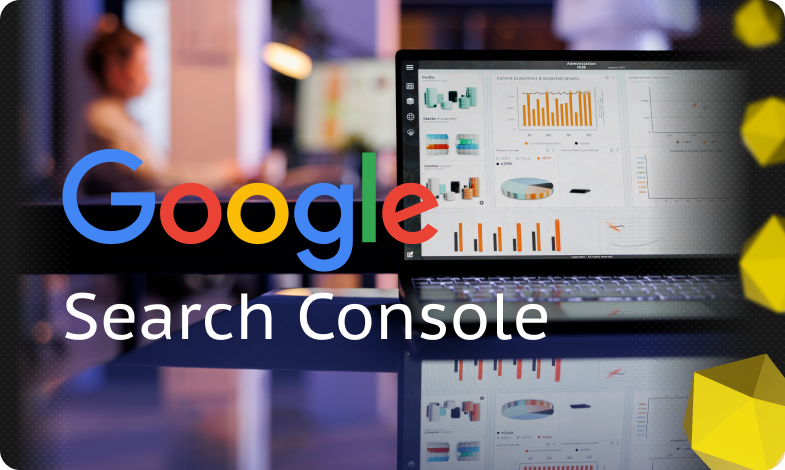Content of the article

Google Search Console (GSC) is a free tool created by Google to give you information about how your site ranks in search results, troubleshoot issues, and optimize your content. It’s not just a useful application to your work, but something you really need to be exclusively at the top of the search results.
Which you can do with Search Console:
- Make sure Google can see and crawl your site;
- Identify indexing issues and re-index after content updates;
- Conduct an assessment of the traffic that comes to your website from Google Search;
- Receive alerts for various faults;
- Find out the list of sites that link to your site;
- eliminate problems with adaptation of the site for mobile devices and with AMP pages.
Who Google Search Console is good for:
- For business owners. If you do not plan to work with GSC yourself, you can simply familiarize yourself with the service to have an idea of Google Search functions and search engine optimization.
- For SEO-specialists and marketers. With the help of Google Search Console, you can track and optimize traffic, view and position of your resource in search results. Apply data from this service when working with content.
- For site administrators. The administrator’s goal is to ensure smooth operation of the resource. Search Console provides an opportunity to track and eliminate server errors, malfunctions with loading, and also to solve issues with malware removal or site hacking. Using this service, you will not lose your position in the search results in case of any changes to your site or maintenance.
- For web developers. If you are creating code or markup for your resource, GSC can help you find and eliminate standard markup problems, such as errors in structured data.
Below in the article, we will also describe the Google Search Console manual and tell you how to use it properly.
How to add a website to Google Search Console
To do this, you need to go to the main page of the tool and click on “Try”. Then you will see a window where you will be asked to choose the type of site: domain or prefixed in the URL.

The difference between these options is that in the first case, the system will monitor data for your entire site (including subdomains, regardless of “www”, “//”, “https://” prefixes). And in the second case, the URL prefix is easier to verify, but information is collected about a specific URL, not the entire site. This is convenient if you need to monitor the performance of specific pages rather than the entire resource.
More often users need to set up surveillance of the entire site, so we will consider this option.
Enter the domain name and click the “Continue” button.
Next, you will see a window where you will need to confirm ownership of the domain with a DNS record.

Once the verification process is over, you can start using Google Search Console for its intended purpose: to optimize your site, increase traffic, and improve your ranking in search results.
How to use Google Search Console
To begin with, let’s look at how the service interface is organized.

All the main menu items are on the left sidebar. There is all the information you will need to work with the added site.
Let’s look at each of the points in more detail below.
1. Review
By default, this item is also the main screen of the Google console. Here you can view general data about the site’s performance, a coverage report, and information about problems with your site.

This report is suitable for daily control, having seen it, you will immediately check and understand whether everything is in order with the site. But, if you need to adjust or change SEO parameters, it is better to evaluate other indicators as well.
2. Efficiency
In this tab, you can view metrics such as:
- number of clicks on selected links;
- number of displays of selected links in the search engine;
- average CTR as a percentage;
- the average position of the site in the search engine.

You can find out more detailed information if you browse through the entire efficiency window and view filters (queries, pages, countries, devices, search type, dates). You can also create these filters yourself.
Analyze requests
In the same tab, you can find out what queries the selected page is ranked for, what position it is located on, and more. To do this, you need to create a new filter:
- click on “New”;
- select the “Page” option;
- check the “Exact URL” filter type;
- enter the address of the site or page to be analyzed.
After these steps, the filters menu will display a full list of keywords that are used in ranking the specified page.
Finding pages with low CTR
In the “Efficiency” tab, you can find pages that appear frequently in the search results and occupy the first positions, but rarely receive clicks. To do this, you need to:
- Filter out those links whose positions are lower than the third. This way we will pay attention to the pages we need.
- After that, analyze keywords with low CTR. If you see an indicator below 30% on the first positions, then you need to think about whether it is worth using this key. Sometimes the problem can also be that the snippet is poorly designed. Then you just need to make the title and description more attractive.
Also, in “Efficiency” you can see in which countries your audience is located; what part of visits comes from mobile devices, and what from computers; see the number of clicks and impressions for each date separately.
3. URL check
This feature is anchored at the top of the Google Webmaster Tools interface and can be accessed from every dashboard window. You need to click on the search box to the right of “Google Search Console” and specify the address to check.

After this action, you will see a small report and understand if this page is showing up in Google search results, if it is scanned and if it is adapted for mobile devices.
If there are no errors in the report, you can request re-indexing by clicking on “Request Indexing”. If there are still errors, click on “Check Results” and see what is wrong. After the errors are corrected, you should request indexing again.
Most likely you will use this section less often than the previous two, but with its help you can see those pages that are poorly optimized.
4. Pages
In the block called “Indexing”, there is a tab called “Pages”. Here you can see problems related to the indexing of the pages of your resource and tips on how to fix them.

Google’s recommendation: if you have less than 500 pages on your site, you may not use this feature.
5. Sitemap files
With the help of this section, you can send the search robot a site map, according to which it will be able to navigate during the indexing of pages.
You need to generate this map from the beginning and send it to the GSC for verification. To do this, in the “Sitemap Files” section, you need to enter the address of the relevant documents and click on “Submit”.
A sitemap can help prioritize the pages you want to be indexed and help you crawl more efficiently. If you need to, you can update your Sitemap files by resubmitting them to Google.
You can also see if there are errors in one or more of the attached maps. If there are, they should be corrected first.
6. Convenience pages
This section allows you to view data on whether your resource is convenient for visitors. Indicators of page usability are also reflected in its position in the rendition.


This report analyzes the usability of the site at the individual URL level. With these results, you can create pages that are more responsive to user needs.
The criteria considered here are:
Key internet indicators
This data can be attributed to the stability and speed of page loading. In this report, you will see a rating for each page: “Low speed”, “Need to increase speed” or “Good”. If a page is rated “Good”, it will be considered as user-friendly.
Mobile-friendly
With this tab you can find out which pages of your resource are displayed incorrectly on mobile devices. This feature will help you to make sure that your site visitors get a quality user experience when they visit your site from smartphones.
The data you’ll see in this report only applies to URLs that are marked as mobile-friendly.
7. Safety issues and manual measures
The “Manual Measures” section is designed to see when a Google employee, not a search engine robot, is dealing with your resource’s errors. To put it another way, this section is the sanctions applied to you by Google for the use of black SEO optimization strategies (buying links to your site, cloaking, overloading the text with keywords, hidden redirects).
If you only use white-hat optimization strategies, you will see information in the report that there are no penalties or problems.

The “Security Issues” section shows security problems with your site, if any. These can be various viruses or hacker operations (e.g., hacking). Pages on which such problems are found will be marked with a warning icon in the search results. And if you try to go to such a resource, you will see information about why you should not do it.
How to fix a security problem:
- Expand the description of the problem;
- Once you’ve familiarized yourself, click “Read More” to find out what to do next;
- With the help of sample URLs, you will be able to determine the cause of the problem (it happens that the list is empty, but this does not mean that there are no such pages, just for some reason Google did not have time to prepare them);
- Eliminate the problem on all pages of the site where it was found (if the problem remains somewhere, your resource will not be shown in the rendition);
- Make sure all problems are corrected;
- Next, click “Request Verification” (in the request, indicate what actions you took – describe the problem; then list the actions by which you resolved it; provide proof of the effectiveness of the actions taken);
- Re-verification requests are reviewed for a certain amount of time (you will receive emails about the progress of the review; do not submit a new request until you receive a final response to the current one, as it will take even longer to review the next one).
8. References
With this section of the GSC, you can view which resources are linking to your site and which pages they are linking to. Linkbuilding is one of the main factors in ensuring successful SEO, so the Links section is very useful.
To summarize
In this article, we looked at what Google Search Console is and how to work with it. Connecting your website to Google Console will give you a big advantage over your competitors. With all the tools that are described above, you will be able to manage all the metrics you need to optimize your site, increase traffic and boost your rankings. All that is required from you is a desire to make a good website and attention to detail. Apply the tool’s control panel to monitor changes on the page, track errors and correct them as quickly as possible. Then you will achieve the desired result. That’s it, no magic.







 11/09/2023
11/09/2023  3922
3922


